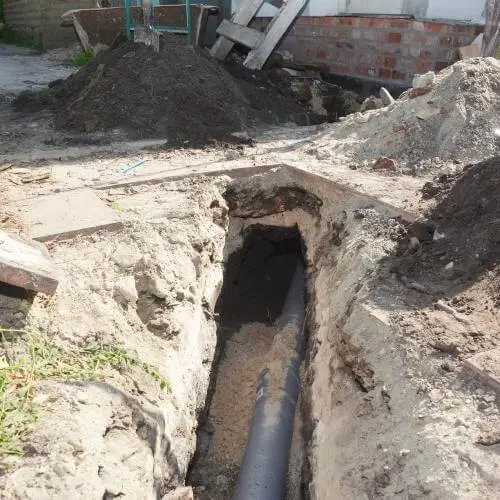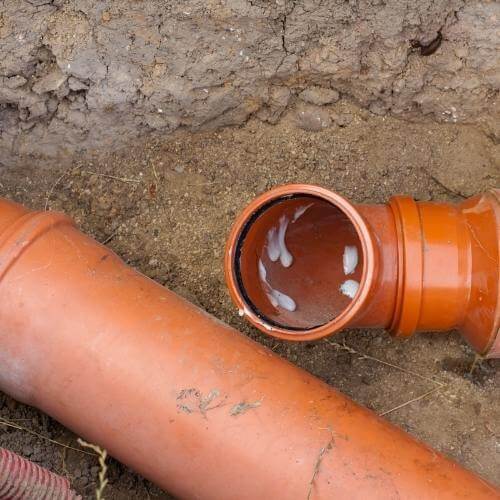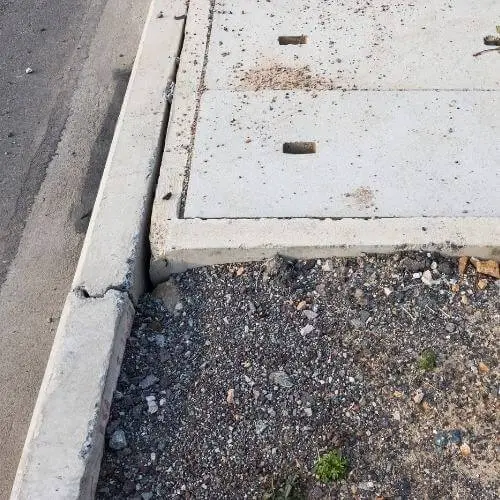Can you build a shed over a sewer line? Whenever we engage in a new building project on our property, we should make sure that whichever project we pick is compatible with our current layout and limitations. One of such limitations can be expressed in underground installations around our homes.
Building restrictions around sewer lines

The space our home provides can at times prove to be rather small for all the possible necessities we wish to use it for. This goes double if we are aiming to build a structure that may ask for a bit more space than we have free.
In these situations, you may consider building a shed to expand your storage space as well as adding more space to the whole property. [1]
Unfortunately, when deciding on such a project, you could run into the issue of the project encompassing areas where sewer pipes lay.
Can You Build a Shed Over a Sewer Line

The answer is a bit grey. While building anything near or too close to a sewer pipe isn’t strictly allowed, there are cases where it could be allowed. What you need there is approval from a local council or other authority figures.
If they discern that it won’t impact the infrastructure in any meaningful way then you may be good to go on the project. The safe distance can vary but it usually peaks at about 3 meters away from the pipes. The space is supposed to give some leeway for the disturbance the construction will cause.
The additional weight can disturb the soil and endanger the composition of the pipe. As you can imagine, the additional weight of a shed has effects on the area below it. Furthermore, the work of constructing a shed alone can result in unwarranted disturbance of the soil which further endangers the pipes. Not only that, repairing the pipes afterwards can be pretty difficult. [2]
Depending on the depth of the pipes, this can be avoided or simply not that felt. However, that’s exactly why you need approval from authorities. The depth of the pipes is already laid out in the official documents so the check won’t even take long.
Can you put a concrete slab over sewer line?

If you are planning to build a shed in your yard, it’s very likely you’ll end up putting a concrete slab below it as a way to prevent sinking issues that may happen. While it’s expected that any building will settle by an inch or two after its construction, we do not want that to yield negative effects.[4]
By having a concrete slab below our shed we avoid issues such as doors being unable to open due to sinking.
As you can imagine, installing a concrete slab has similar effects to constructing a shed above your sewer pipes. The slab could press onto the soil, disallowing pipes from properly contracting or extending as the temperature changes or sudden surges of water come flowing. Mind you, while these variations in size are barely noticeable to the human eye, they heavily impact the function of a sewer pipe. The sewer pipe could end up leaking or even cracking as the extra pressure of pushed soil lays on top of it.
Damaged sewer pipe is something that you do not want in your yard or anywhere near your home. It can cause issues within the yard which include pooling of sewage water and bad smells in the yard.
Can You Build A Shed Over a Sewer Line

If you wish to build anything over or close to public sewers and lateral drains, an approval of corresponding authorities is required. It is important that all pipes are kept safe and functional. While risks we’ve discussed previously exist, certain areas could be able to support the extra weight. However, it pays to contact both your local city council and water company representatives to confirm it’s a legit building engagement that you are doing.
Usually, the approval will depend on the depth the pipes are located on, the material they are made out of, and of course the weight of the item being constructed above them. The risk calculations will be carried out by other involved bodies and if they decide it’s alright to construct above a sewer pipe you can commit to the project.
It’s safe to say that you should avoid it regardless if possible. If possible, move the project a few meters away to conform to the limitations. In case you don’t want to bother with approval that is. It could also be a better choice for your construction to move the location a bit.
While your project could have negative effects on a sewer pipe so can a sewer pipe have negative effects on it. A burst pipe could cause water damage to the construction above it as well as fill it with the smell of sewage.
Building over sewer line qld
If you are conforming to qld you have a few more things to keep in mind. Namely, where it applies as well as where it doesn’t. Knowing this can really enhance the overall construction experience
Where it applies
When you are planning building work that is to be carried on a property that contains or is close to infrastructure. That can affect the whole area so it makes sense why these cases would deserve some extra consideration.
In case the lot construction will take place in is adjacent to a part of the infrastructure, you will end up with some issues too. These fall into the qld regulation and will need to be cleared appropriately.
Lastly, land that is the subject of an easement has the standard regulations applied too. However, it is required that they are registered by a relevant service provider to achieve this coverage.
Where it doesn’t
If your work is located far away enough from a specific bit of infrastructure you have nothing to worry about. However, the distance will change depending on the class of the infrastructure.
The construction has to be at least 3 meters away from Class 1, single houses, and Class 10, private garage or any similar non-habitable structure, buildings. This is very important to keep in mind due to the potential overlap our construction work may have with these areas.
It also doesn’t apply to buildings built over 5 meters away from buildings that are classed from Class 2 to Class 9. Considering the number of occupants of some of these classes, apartment complexes are included in some of those classes, it makes sense why you’d require a greater separation.
After all, the sewer installations there will be a lot more elaborate which brings more opportunity to affect something when committing to a construction project. Not to mention that repairs of such areas can be even pricier so initial safety measures of setting them further apart from new construction usually works better.
Now if your construction work is to take place near ground anchors or rock bolts, you’ll need to push it quite a bit further away. More specifically, at least 10 meters away.
Any repairs or alterations that don’t change the building’s floor surface are also exempt from the potential issues with the code.
Can you concrete over sewage pipes?

This is a bit of a layered question. While you can pour concrete over sewer pipes there are important preparations to do before actually pouring concrete. The key to success is utilizing a gravel bed that wraps around the pipe. This bed will allow you to fully wrap the pipe without any gaps being left open.
The reason we cover these pipes in gravel bed is due to the weight of the concrete above the pipe potentially cracking the pipe. While this isn’t an immediate process, it does slowly turn your pipe brittle until the point of cracking. Make sure every gap is properly filled and no holes have been left in the gravel bed defense.
The depth is also important. As we’ve noted before, if you pour down concrete and then decide to build something on top of it, there are going to be disturbances in the soil. Depending on the depth, it’s possible it’ll cause shifting of the area around the pipe or the pipe itself.
After the gravel bed has been wrapped around the pipe, you can proceed with the pouring of concrete regularly. The established protections will leave them well-wrapped and your mind at peace.
Conclusion
The overall experience of your new construction project can easily be enhanced with some forward-thinking. As we’ve seen, the complications that may arise if we do not follow the proper procedures can affect us in more ways than one.
We could get in legal troubles, end up with sewer pipe issues, or even have the construction itself damaged by the side effects it causes. Complying with the code as well as making sure the current spot you are building on is safe is key to a successful construction that won’t cause unnecessary issues later down the line. If you are left with a more specific question in mind, it pays to contact local sources of information to figure everything out.

Michael Davis is a heating & plumbing expert who currently works as independent contractor in SC. He also writes for Plumbertip.
For almost 10 years he worked on various plumbing tasks across South Carolina.


